Impact of Climate Change on the Hydrological Regimes of the Midstream Section of the Yarlung Tsangpo River Basin Based on SWAT Model
Abstract
1. Introduction
2. Materials and Methods
2.1. Study Area
2.2. Description of SWAT
2.3. Model Setup and Calibration
2.4. Future Climate Scenarios
3. Results
3.1. Model Performance
3.2. Variation of Total Runoff and Its Components
3.3. Future Climate Analysis
3.4. Variation in Runoff under Future Climate Change
4. Discussion
4.1. Influences of Climate Change on Runoff Processes
4.2. Uncertainties and Prospects
5. Conclusions
Supplementary Materials
Author Contributions
Funding
Data Availability Statement
Conflicts of Interest
References
- Bekele, E.G.; Knapp, H.V. Watershed modeling to assessing impacts of potential climate change on water supply availability. Water Resour. Manag. 2010, 24, 3299–3320. [Google Scholar]
- Zhang, R.H.; Su, F.G.; Jiang, Z.H.; Gao, X.J.; Guo, D.L.; Ni, J.; You, Q.L.; Lan, C.; Zhou, B.T. Advances in climate and environmental change prediction on the Tibetan Plateau in the 21st century. Sci. Bull. 2015, 60, 3036–3047. (In Chinese) [Google Scholar]
- Rabezanahary, T.M.F.; Rahaman, M.; Zhai, J. Assessment of the future impact of climate change on the hydrology of the mangoky river, madagascar using ANN and SWAT. Water 2021, 13, 1239. [Google Scholar]
- Masson-Delmotte, V.; Zhai, P.; Pirani, A.; Connors, S.L.; Péan, C.; Berger, S.; Caud, N.; Chen, Y.; Goldfarb, L.; Gomis, M.I.; et al. Climate change 2021: The physical science basis. In Contribution of Working Group I to the Sixth Assessment Report of the Intergovernmental Panel on Climate Change; Cambridge University Press: Cambridge, UK; New York, NY, USA, 2021; Volume 2. [Google Scholar]
- Sun, H. Response of Runoff to Climate Change in Different Sub-Basins of the Yarlung Tsangpo River. Doctor Thesis, University of Chinese Academy of Sciences, Beijing, China, 2021. (In Chinese). [Google Scholar]
- Barry, R.G. Mountain climate change and cryospheric responses: A review. World Mt. Symp. 2001. Available online: https://lib.icimod.org/record/10655/files/930.pdf (accessed on 10 February 2020).
- Bürki, R.; Elsasser, H.; Abegg, B. Climate change-impacts on the tourism industry in mountain areas. In Proceedings of the 1st International Conference on Climate Change and Tourism, Djerba, Tunisia, 9–11 April 2003. [Google Scholar]
- Kuang, X.; Jiao, J.J. Review on climate change on the Tibetan Plateau during the last half century. J. Geophys. Res. Atmos. 2016, 121, 3979–4007. [Google Scholar]
- Liu, X.; Chen, B. Climatic warming in the Tibetan Plateau during recent decades. Int. J. Climatol. 2000, 20, 1729–1742. [Google Scholar] [CrossRef]
- Li, L.; Yang, S.; Wang, Z.; Zhu, X.; Tang, H. Evidence of warming and wetting climate over the Qinghai-Tibet Plateau. Arct. Antarc. Alp. Res. 2010, 42, 449–457. [Google Scholar] [CrossRef]
- Wang, B.; Bao, Q.; Hoskins, B.; Wu, G.; Liu, Y. Tibetan Plateau warming and precipitation changes in East Asia. Geophys. Res. Lett. 2008, 35, L14702. [Google Scholar] [CrossRef]
- Jiang, K. Runoff Composition of the Yarlung Tsangpo River Basin and Its Response to Climate Change. Master’s Thesis, Harbin Institute of Technology, Harbin, China, 2020. (In Chinese). [Google Scholar]
- Gao, H.; He, X.; Ye, B.; Pu, J. Modeling the runoff and glacier mass balance in a small watershed on the Central Tibetan Plateau, China, from 1955 to 2008. Hydrol. Process. 2012, 26, 1593–1603. [Google Scholar] [CrossRef]
- Li, F.; Zhang, Y.; Xu, Z.; Teng, J.; Liu, C.; Liu, W.; Mpelasoka, F. The impact of climate change on runoff in the southeastern Tibetan Plateau. J. Hydrol. 2013, 505, 188–201. [Google Scholar] [CrossRef]
- Zhang, L.; Su, F.; Yang, D.; Hao, Z.; Tong, K. Discharge regime and simulation for the upstream of major rivers over Tibetan Plateau. J. Geophys. Res. Atmos. 2013, 118, 8500–8518. [Google Scholar]
- Jin, H.; Ju, Q.; Yu, Z.; Hao, J.; Gu, H.; Gu, H.; Li, W. Simulation of snowmelt runoff and sensitivity analysis in the Nyang River Basin, southeastern Qinghai-Tibetan Plateau, China. Nat. Hazards 2019, 99, 931–950. [Google Scholar]
- Wang, X.; He, K.; Dong, Z. Effects of climate change and human activities on runoff in the Beichuan River Basin in the northeastern Tibetan Plateau, China. Catena 2019, 176, 81–93. [Google Scholar] [CrossRef]
- Zhang, F.; Shi, X.; Zeng, C.; Wang, L.; Xiao, X.; Wang, G.; Chen, Y.; Zhang, H.; Lu, X.; Immerzeel, W. Recent stepwise sediment flux increase with climate change in the Tuotuo River in the central Tibetan Plateau. Sci. Bull. 2020, 65, 410–418. [Google Scholar] [CrossRef]
- Pant, R.R.; Zhang, F.; Rehman, F.U.; Wang, G.; Ye, M.; Zeng, C.; Tang, H. Spatiotemporal variations of hydrogeochemistry and its controlling factors in the Gandaki River Basin, Central Himalaya Nepal. Sci. Total Environ. 2018, 622–623, 770–782. [Google Scholar] [CrossRef]
- Huang, X. A Study on the Carrying Capacity of Water Resources in the Yarlung Tsangpo River Basin Based on Water Cycle Processes. Master’s Thesis, University of Chinese Academy of Sciences, Beijing, China, 2016. (In Chinese). [Google Scholar]
- Tang, X.P.; Liu, Y.L.; Zhang, J.Y.; Wang, G.Q.; Li, X.G.; Jin, J.L.; Bao, Z.X.; Liu, C.S.; Wang, G.X. Simulation and prediction of runoff processes in the watershed above Lhaze of the Yarlung Tsangpo River under climate change. Hydrology 2018, 6, 24–30. (In Chinese) [Google Scholar]
- Liu, W.F.; Xu, Z.X.; Li, F.P.; Su, L.Q. Climate change scenarios in the Yarlung Zangbo River basin based on ASD model. Plateau Meteorol. 2014, 33, 26–36. (In Chinese) [Google Scholar]
- Nie, N.; Zhang, W.C.; Deng, C. Spatial and temporal climate changes and future trends in the Yarlung Tsangpo River basin from 1978 to 2009. J. Glacial Permafr. 2012, 34, 64–71. (In Chinese) [Google Scholar]
- Gao, B.; Yang, D.W.; Liu, Z.Y.; Zhu, C.B. Distributed hydrological simulation and runoff variability analysis in the Yarlung Tsangpo River basin. Hydrology 2008, 28, 40–44. (In Chinese) [Google Scholar]
- Wang, L.; Chen, X.W. Advances in SWAT model watershed runoff simulation. J. Huaqiao Univ. (Nat. Sci. Ed.) 2008, 29, 6–10. (In Chinese) [Google Scholar]
- Wang, X.; Shang, S.; Yang, W.; Clary, C.R.; Yang, D. Simulation of land use–soil interactive effects on water and sediment yields at watershed scale. Ecol. Eng. 2010, 36, 328–344. [Google Scholar]
- Ouyang, W.; Huang, H.; Hao, F.; Guo, B. Synergistic impacts of land-use change and soil property variation on non-point source nitrogen pollution in a freeze–Thaw area. J. Hydrol. 2013, 495, 126–134. [Google Scholar]
- Yu, Z.L.; Mu, X.L. Progress of domestic runoff simulation by SWAT model. Zhihuai 2014, 4, 21–22. (In Chinese) [Google Scholar]
- Zuo, D.; Xu, Z.; Yao, W.; Jin, S.; Xiao, P.; Ran, D. Assessing the effects of changes in land use and climate on runoff and sediment yields from a watershed in the Loess Plateau of China. Sci. Total Environ. 2016, 544, 238–250. [Google Scholar] [CrossRef]
- Dou, X.D.; Huang, W.; Yi, Q.; Liu, X.Z.; Zuo, H.T.; Li, M.; Li, Z.L. Impacts of LUCC and climate change on runoff in the Lancang River basin. Acta Ecol. Sin. 2019, 39, 4687–4696. (In Chinese) [Google Scholar]
- Zhang, X.Y.; Li, J.; Yang, Y.Z.; You, Z. Simulation of runoff in the Yangtze River source area based on SWAT model. J. Northwest For. Acad. 2012, 27, 38–44. (In Chinese) [Google Scholar]
- Wang, J.Q.; Zheng, Y.F. Preliminary analysis of the applicability of SWAT model in the three river source region. Meteorol. Environ. Sci. 2014, 37, 102–107. (In Chinese) [Google Scholar]
- Zhou, J.; Wang, L.; Zhang, Y.; Guo, Y.; Li, X.; Liu, W. Exploring the water storage changes in the largest lake (Selin Co) over the Tibetan Plateau during 2003–2012 from a basin-wide hydrological modeling. Water Resour. Res. 2015, 51, 8060–8086. [Google Scholar]
- Shi, X.N.; Zhang, F.; Lu, X.X.; Wang, Z.Y.; Gong, T.L.; Wang, G.X.; Zhang, H.B. Spatiotemporal variations of suspended sediment transport in the upstream and midstream of the Yarlung Tsangpo River (the upper Brahmaputra), China. Earth Surf. Process. Landf. 2018, 43, 432–443. [Google Scholar] [CrossRef]
- Arnold, J.G.; Srinivasan, R.; Muttiah, R.S.; Williams, J.R. Large area hydrologic modeling and assessment part I: Model development. J. Am. Water Resour. Assoc. 1998, 34, 73–89. [Google Scholar]
- Wang, Z.G.; Liu, C.M.; Huang, Y.B. Research on the principle, structure and application of SWAT model. Adv. Geogr. Sci. 2003, 22, 79–86. (In Chinese) [Google Scholar]
- Abbaspour, K.C.; Yang, J.; Maximov, I.; Siber, R.; Bogner, K.; Mieleitner, J.; Zobrist, J.; Srinivasan, R. Modelling hydrology and water quality in the pre-ailpine/alpine Thur watershed using SWAT. J. Hydrol. 2007, 333, 413–430. [Google Scholar] [CrossRef]
- USDA-SCS. National Engineering Handbook: Section 4 Hydrology; U.S. Department of Agriculture, Soil Conservation Service: Washington, DC, USA, 1972.
- Green, W.H.; Ampt, G.A. Studies on soil physics. The flow of air and water through soils. J. Agric. Sci. 1911, 4, 11–24. [Google Scholar]
- Fontaine, T.A.; Cruickshank, T.S.; Arnold, J.G.; Hotchkiss, R.H. Development of a snowfall–snowmelt routine for mountainous terrain for the soil water assessment tool (SWAT). J. Hydrol. 2002, 262, 209–223. [Google Scholar] [CrossRef]
- Zhang, F.; Zhang, H.B.; Hagen, S.C.; Ye, M.; Wang, D.; Gui, D.; Zeng, C.; Tian, L.; Liu, J. Snow cover and runoff modelling in a high mountain catchment with scarce data: Effects of temperature and precipitation parameters. Hydrol. Process. 2015, 29, 52–65. [Google Scholar]
- Nash, J.E.; Sutcliffe, J.V. River flow forecasting through conceptual models part I-A discussion of principles. J. Hydrol. 1970, 10, 282–290. [Google Scholar] [CrossRef]
- Gupta, H.; Sorooshian, S.; Yapo, P. Status of automatic calibration for hydrologic models: Comparison with multilevel expert calibration. J. Hydrol. Eng. 1999, 4, 135–143. [Google Scholar] [CrossRef]
- Moriasi, D.N.; Arnold, J.G.; Van Liew, M.W.; Bingner, R.L.; Harmel, R.D.; Veith, T.L. Model evaluation guidelines for systematic quantification of accuracy in watershed simulations. Transations ASABE 2007, 50, 885–900. [Google Scholar] [CrossRef]
- Wang, X.L. Study on the impact of climate change on water circulation processes in the Pamir Plateau-Karakorum-Kunlun Mountains snow-ice basin. Doctor Thesis, University of Chinese Academy of Sciences, Beijing, China, 2016. [Google Scholar]
- Kudo, R.; Yoshida, T.; Masumoto, T. Uncertainty analysis of impacts of climate change on snow processes: Case study of interactions of GCM uncertainty and an impact model. J. Hydrol. 2017, 548, 196–207. [Google Scholar] [CrossRef]
- Zhang, Q.; Shen, Z.; Xu, C.; Sun, P.; Hu, P.; He, C. A new statistical downscaling approach for global evaluation of the CMIP5 precipitation outputs: Model development and application. Sci. Total Environ. 2019, 690, 1048–1067. [Google Scholar]
- Li, Z.; Li, Q.; Wang, J.; Feng, Y.R.; Shao, Q.X. Impacts of projected climate change on runoff in upper reach of Heihe River basin using climate elasticity method and GCMs. Sci. Total Environ. 2020, 716, 137072. [Google Scholar] [CrossRef] [PubMed]
- Chen, J.; Brissette, F.P.; Leconte, R. Uncertainty of downscaling method in quantifying the impact of climate change on hydrology. J. Hydrol. 2011, 401, 190–202. [Google Scholar]
- Van, R.L.; Christensen, J.H.; Butts, M.B.; Jensen, K.H.; Refsgaard, J.C. An intercomparison of regional climate model data for hydrological impact studies in Denmark. J. Hydrol. 2010, 380, 406–419. [Google Scholar]
- Hay, L.E.; Wilby, R.L.; Leavesley, G.H. A comparison of Delta change and downscaled GCM scenarios for three mountainous basins in the United States. J. Am. Water Resour. Assoc. 2000, 36, 387–397. [Google Scholar] [CrossRef]
- Wang, R. Effects of Climate and Subsurface Changes on Runoff in the Middle Reaches of the Yarlung Tsangpo River Basin. Doctor Thesis, University of Chinese Academy of Sciences, Beijing, China, 2015. [Google Scholar]
- Kayastha, R.B. Study of Glacier Ablation in the Nepalese Himalayas by the Energy Balance Model and Positive Degree-Day Method. Doctor Thesis, Nagoya University, Nagoya, Japan, 2001. [Google Scholar]
- Sun, H.; Su, F.G. Precipitation correction and reconstruction for streamflow simulation based on 262 rain gauges in the upper Brahmaputra of southern Tibetan Plateau. J. Hydrol. 2020, 590, 125484. [Google Scholar]
- Wu, Q.; Kang, S.; Gao, T.; Zhang, Y. The characteristics of the positive degree-day factors of the Zhadang glacier on the Nyainqentanglha range of Tibetan Plateau, and its application. J. Glaciol. Geocryol. 2010, 32, 891–897. (In Chinese) [Google Scholar]
- Liu, J.; Zhang, W. Reconstructed glacier mass balance in the past few decades with the latest GRACE and GLDAS products over the Yarlung Zangbo River Basin, China. In Fifth Recent Advances in Quantitative Remote Sensing; Sobrino Rodríguez, J.A., Ed.; Universitat de València: Valencia, Spain, 2018. [Google Scholar]
- Singh, V.; Jain, S.K.; Shukla, S. Glacier change and glacier runoff variation in the Himalayan Baspa river basin. J. Hydrol. 2021, 593, 125918. [Google Scholar] [CrossRef]
- Qi, W.; Feng, L.; Liu, J.G.; Yang, H. Snow as an Important Natural Reservoir for Runoff and Soil Moisture in Northeast China. Journal of Geophysical Research. Atmospheres 2020, 125, e2020JD033086. [Google Scholar]
- Zhang, Y.; Luo, Y.; Sun, L.; Liu, S.; Chen, X.; Wang, X. Using glacier area ratio to quantify effects of melt water on runoff. J. Hydrol. 2016, 538, 269–277. [Google Scholar]
- Liu, T.Q. Hydrological characteristics of the Yarlung Tsangpo River. J. Geogr. 1999, 54, 157–164. (In Chinese) [Google Scholar]
- Yao, Y.; Zheng, C.; Andrews, C.B.; Scanlon, B.R.; Kuang, X.; Zeng, Z.; Jeong, S.J.; Lancia, M.; Wu, Y.; Li, G. Role of groundwater in sustaining northern Himalayan rivers. Geophys. Res. Lett. 2021, 48, e2020GL092354. [Google Scholar]
- Tan, H.; Chen, X.; Shi, D.; Rao, W.; Liu, J.; Liu, J.; Eastoe, C.J.; Wang, J. Base flow in the Yarlungzangbo River, Tibet, maintained by the isotopically-depleted precipitation and groundwater discharge. Sci. Total Environ. 2021, 759, 143510. [Google Scholar] [CrossRef]
- Zhao, Z.C.; Fu, Q.; Gao, C.; Zhang, X.J.; Xu, Y.P. Simulation of monthly runoff in Yarlung Tsangpo River considering runoff components. Hydrology 2017, 37, 26–30. (In Chinese) [Google Scholar]
- Budyko, M.I. Climate and Life; Academic Press: Salt Lake City, UT, USA, 1974. [Google Scholar]
- Liu, M.L.; Wang, Z.J.; Zhu, L.L.; Lv, J.P. Gray correlation analysis between evapotranspiration and meteorological factors in Qiqihar region. Northeast Water Conserv. Hydropower 2018, 36, 12–16. (In Chinese) [Google Scholar]
- Wang, H.; Mei, Z.M. Spatial and temporal variation of surface evapotranspiration in Guizhou Province and its relationship with climate factors. Soil Water Conserv. Res. 2020, 27, 221–229. (In Chinese) [Google Scholar]
- Chen, L.L.; Mo, S.H.; Gong, Y. Identification of attribution of runoff changes in the Jialu River basin based on Budyko's elasticity coefficient method. J. Water Resour. Water Eng. 2021, 32, 110–116. (In Chinese) [Google Scholar]
- Zhang, J.Y.; Lun, Y.R.; Liu, L.; Liu, Y.X.; Li, X.; Xu, Z.X. Adaptation assessment of CMIP6 multi-model on the Tibetan Plateau and prediction of future climate change. J. Beijing Norm. Univ. 2022, 58, 77–89. (In Chinese) [Google Scholar]
- Meng, Y.L.; Duan, K.Q.; Shang, D.; Li, S.S.; Xing, L.; Shi, P.H. Analysis of spatial and temporal variation of surface air temperature on the Tibetan Plateau from 1961 to 2100 based on CMIP6 data. Glacial Permafr. 2022, 44, 1–10. (In Chinese) [Google Scholar]
- Cao, H.Y. Remote Sensing-Based Inversion of Permafrost in the Yellow River Source Area and the Influence of Permafrost Changes on Runoff. Master’s Thesis, China University of Geosciences, Beijing, China, 2021. (In Chinese). [Google Scholar]
- Chang, Q.X. Water Sources of River Runoff and Their Seasonal Variation Patterns in Alpine Mountainous Areas. Doctor Thesis, China University of Geosciences, Beijing, China, 2019. [Google Scholar]
- Wang, Y.; Zhang, Y.; Chiew, F.H.S.; McVicar, T.R.; Zhang, L.; Li, H.; Qin, G. Contrasting runoff trends between dry and wet parts of eastern Tibetan Plateau. Sci. Rep. 2017, 7, 15458. [Google Scholar] [PubMed]
- Zhao, L.; Hu, G.J.; Zou, D.F.; Wu, X.D.; Ma, L.; Sun, Z.; Yuan, L.M.; Zhou, H.Y.; Liu, S.B. Impact of multi-year permafrost changes on hydrological processes on the Tibetan Plateau. Proc. Chin. Acad. Sci. 2019, 34, 1233–1246. (In Chinese) [Google Scholar]
- Kurylyk, B.L.; MacQuarrie, K.T.B.; Mckenzie, J.M. Climate change impacts on groundwater and soil temperatures in cold and temperate regions: Implications, mathematical theory, and emerging simulation tools. Earth Sci. Rev. 2014, 138, 313–334. [Google Scholar] [CrossRef]
- Evans, S.G.; Ge, S.; Liang, S. Analysis of groundwater flow in mountainous, headwater catchments with permafrost. Water Resour. Res. 2015, 51, 9564–9576. [Google Scholar]
- Su, F.; Zhang, L.; Ou, T.; Chen, D.; Yao, T.; Tong, K.; Qi, Y. Hydrological response to future climate changes for the major upstream river basins in the Tibetan Plateau. Glob. Planet. Change 2016, 136, 82–95. [Google Scholar]
- Lutz, A.F.; Immerzeel, W.W.; Shrestha, A.B.; Bierkens, M.F.P. Consistent increase in High Asia’s runoff due to increasing glacier melt and precipitation. Nat. Clim. Change 2014, 4, 587–592. [Google Scholar]
- Tang, Q.H.; Lan, C.; Su, F.G.; Liu, X.C.; Sun, H.; Ding, J.; Wang, L.; Len, G.Y.; Zhang, Y.Q.; Sang, Y.F.; et al. Streamflow change on the Qinghai-Tibet Plateau and its impacts. Chin. Sci. Bull. 2019, 64, 2807–2821. (In Chinese) [Google Scholar]
- Nepal, S.; Shrestha, A.B. Impact of climate change on the hydrological regime of the Indus, Ganges and Brahmaputra river basins: A review of the literature. Int. J. Water Resour. Dev. 2015, 31, 201–218. [Google Scholar] [CrossRef]
- Qin, D.H.; Ding, Y.H.; Su, J.L.; Ren, J.W.; Wang, S.W.; Wu, R.S.; Yang, X.Q.; Wang, S.M.; Liu, S.Y.; Dong, G.R.; et al. Assessment of climate and evironment changes in China (I): Climate and evnironment changes in China and their projection. Adv. Clim. Chang. Res. 2005, 1, 4–9. (In Chinese) [Google Scholar]
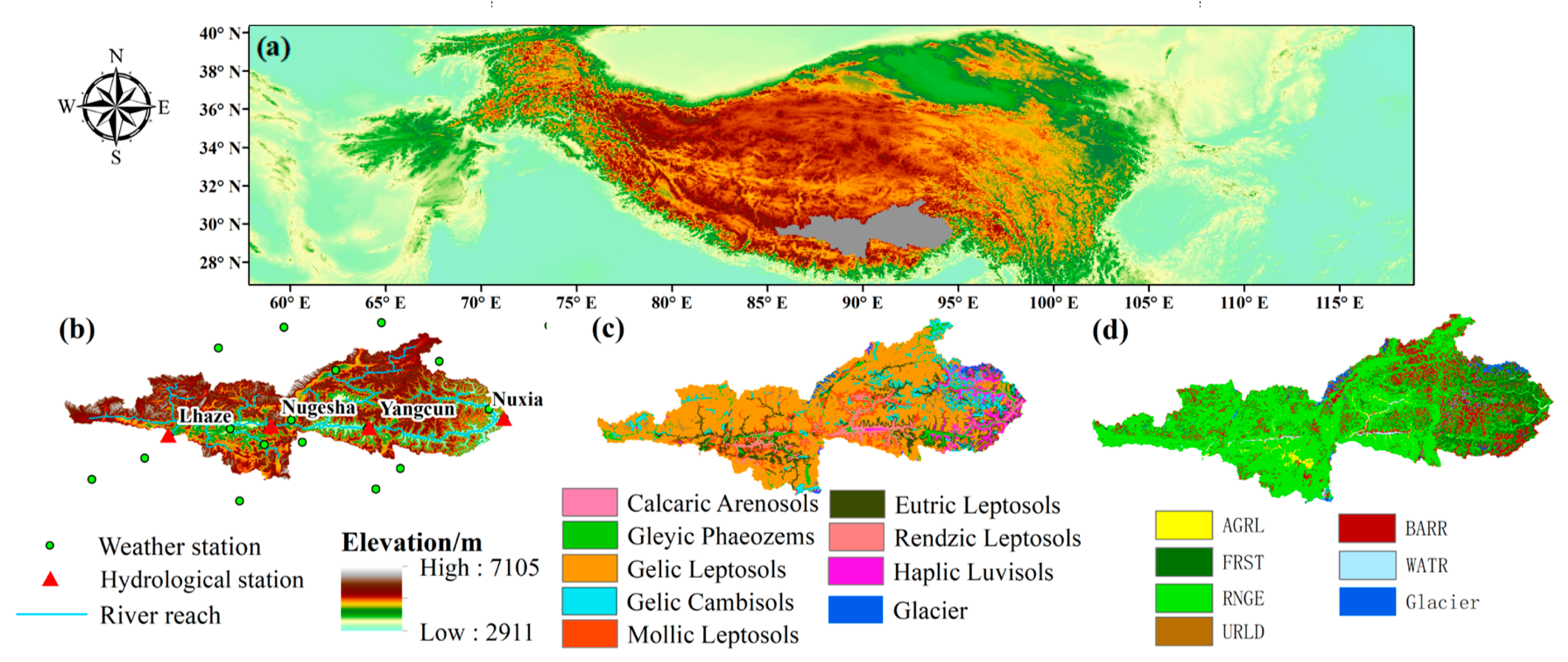

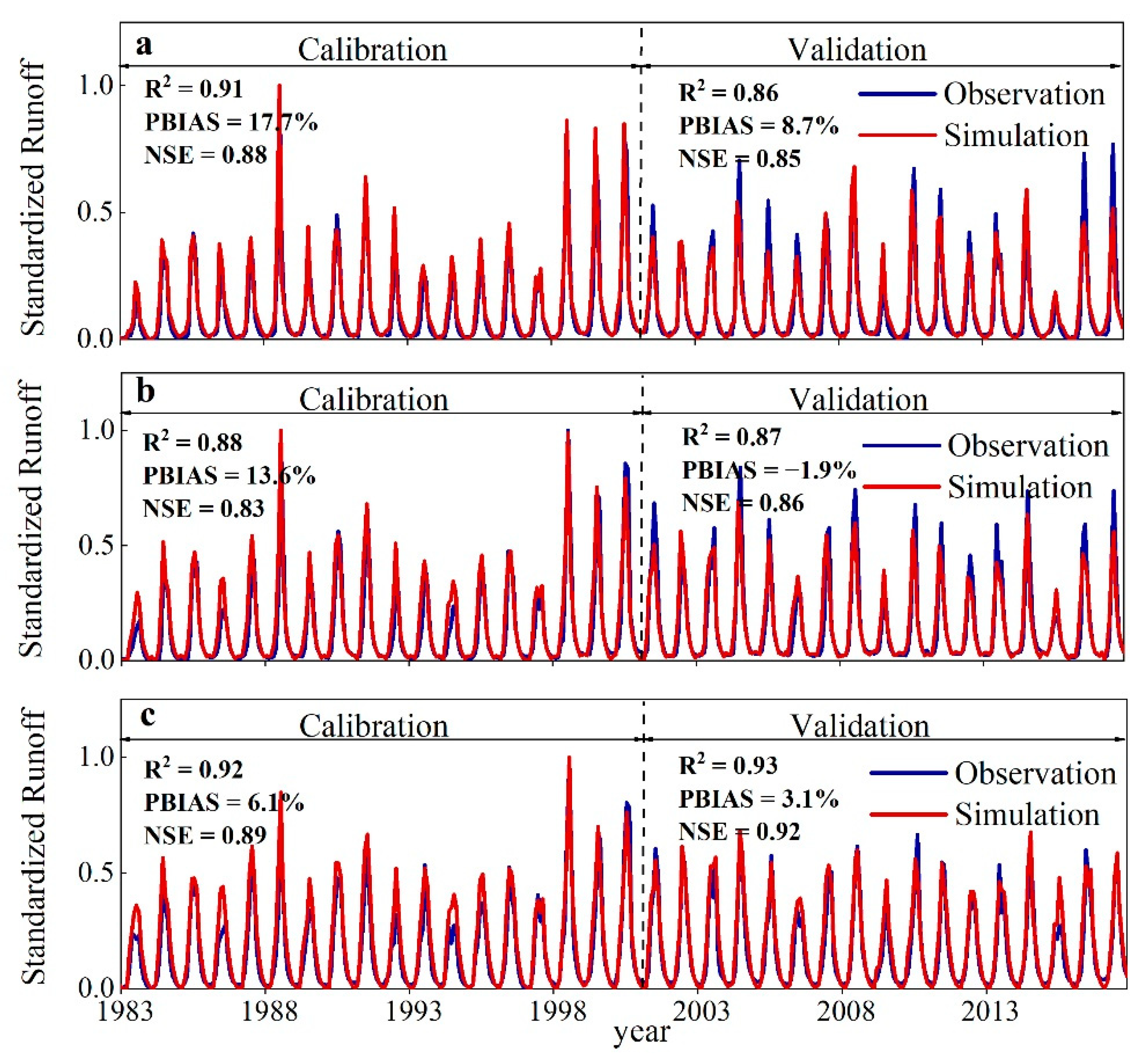

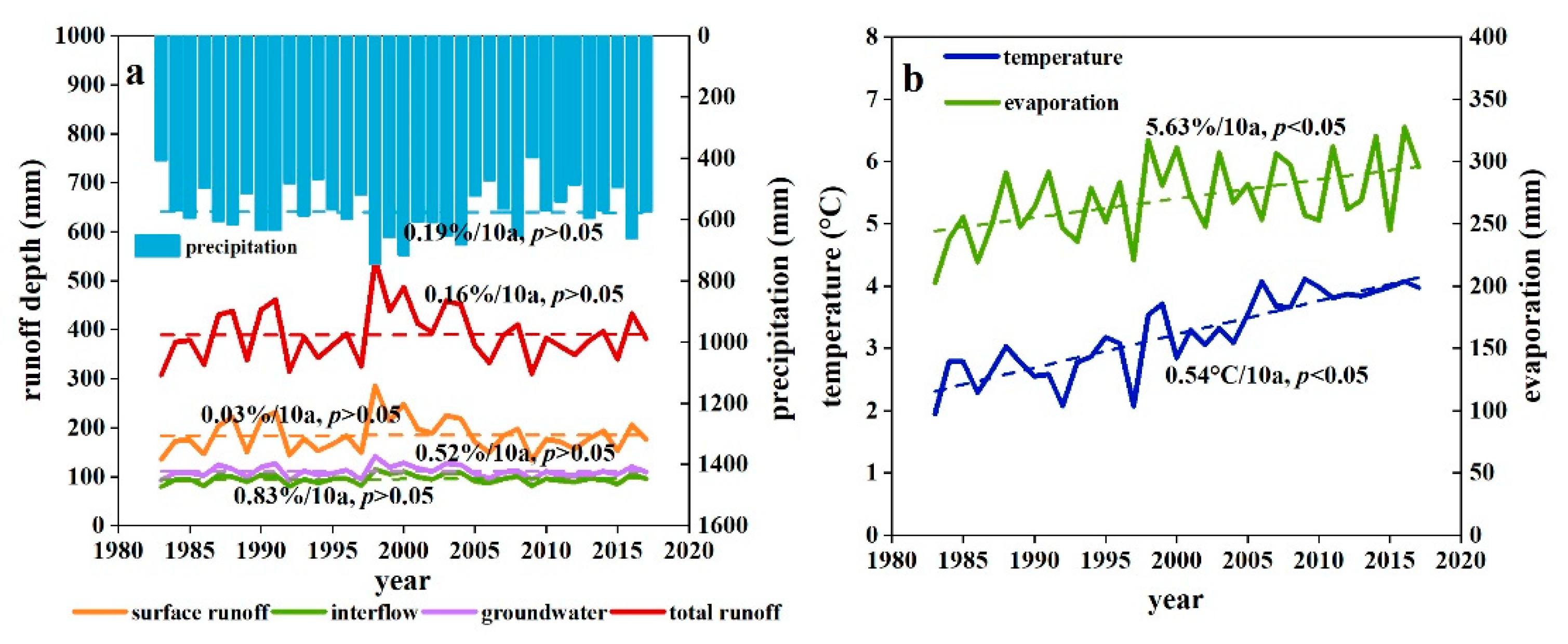

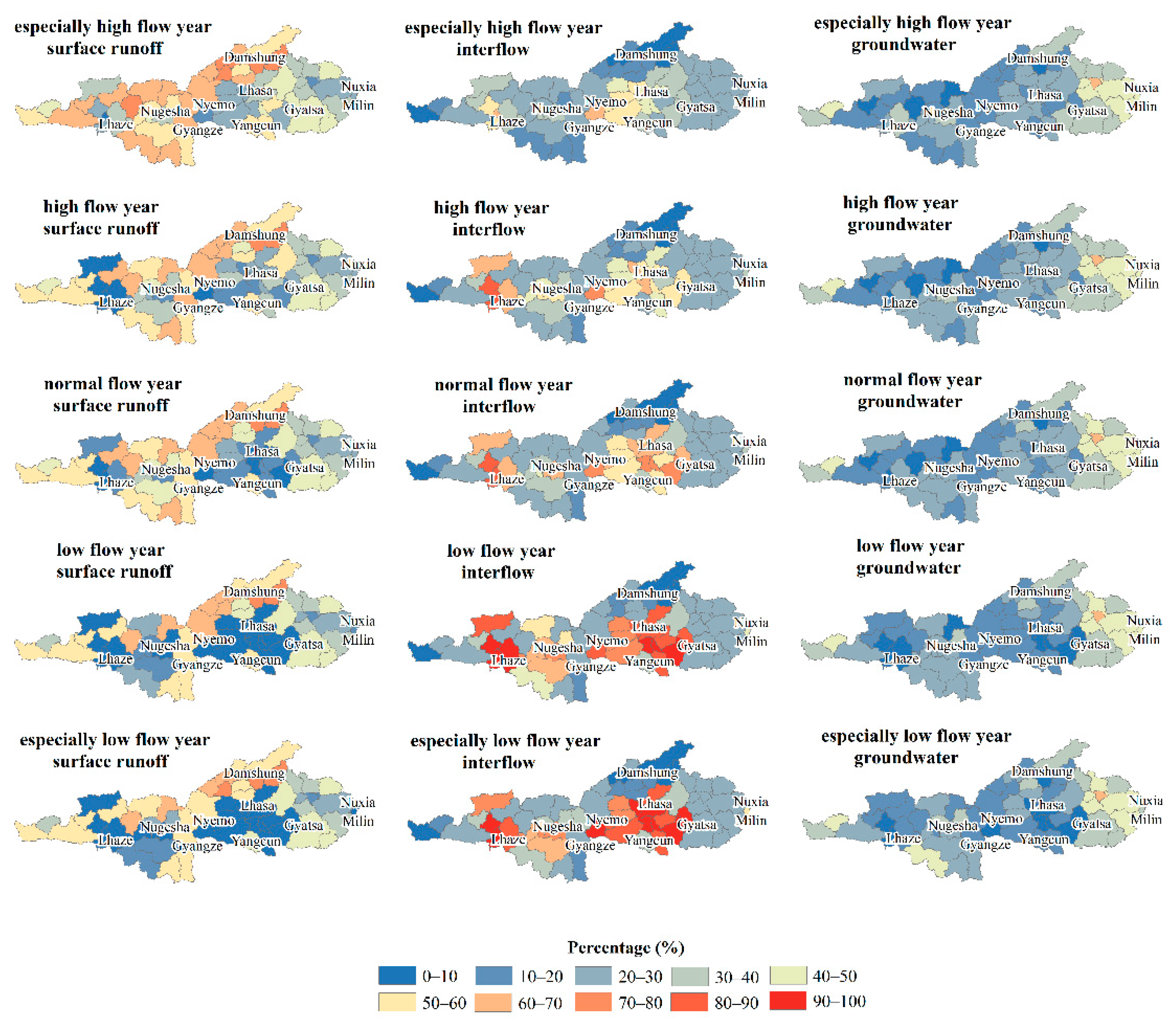
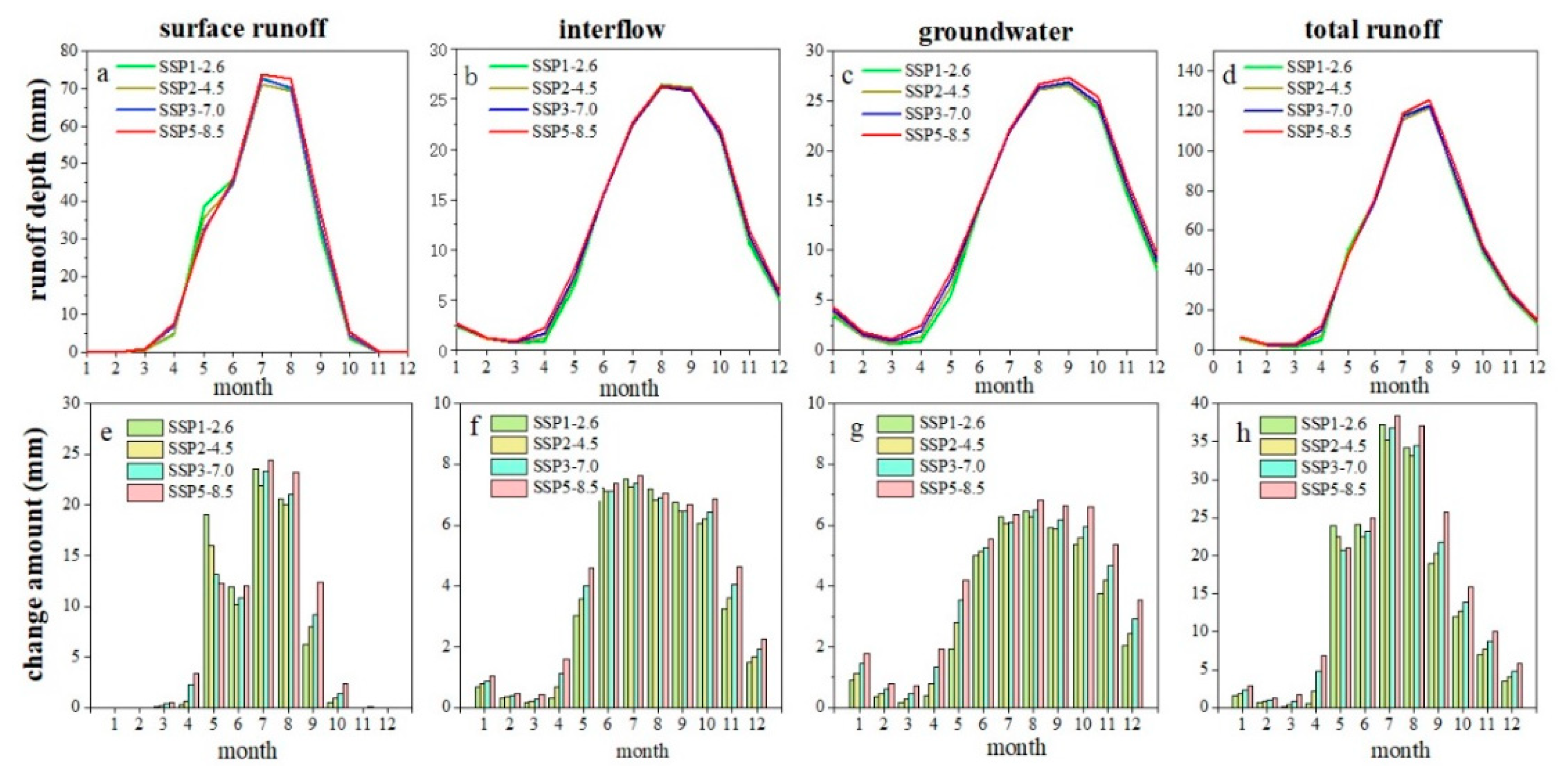
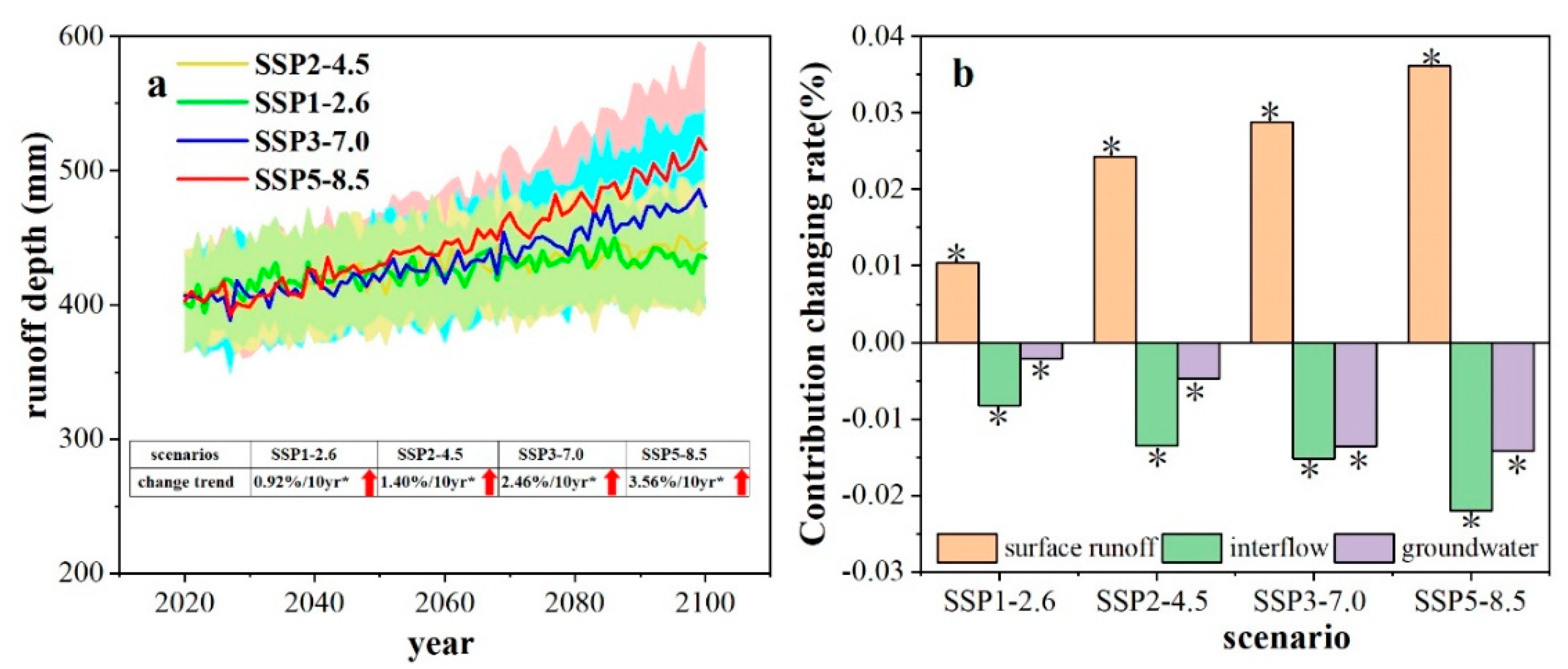
| Data Type | Name | Resolution | Source |
|---|---|---|---|
| Spatial data | DEM | 90 m | https://www.gscloud.cn/sources/accessdata/305?pid=302 (accessed on 1 February 2020) |
| Land use | 1 km | https://www.resdc.cn/DOI/DOI.aspx?DOIID=54 (accessed on 10 February 2020) | |
| Soil type | 1 km | https://www.fao.org/soils-portal/soil-survey/soil-maps-and-databases/harmonized-world-soil-database-v12/en/ (accessed on 10 February 2020) | |
| Meteorological data | Precipitation, temperature, wind speed, relative humidity | Daily | https://www.resdc.cn/data.aspx?DATAID=230 (accessed on 20 February 2020) |
| Hydrological data | Runoff | Monthly | Hydrological and Water Resources Survey Bureau of Tibet (Lhaze, Nugesha, Yangcun, Nuxia Hydrological stations) |
| Snow cover | MOD10CM | Monthly | https://search.earthdata.nasa.gov/search/granules?p=C1646609754-NSIDC_ECS&pg (accessed on 20 October 2020) |
| Lhaze to Nugesha | Nugesha to Yangcun | Yangcun to Nuxia | |
|---|---|---|---|
| Glacier area (km2) | 493.35 | 768.24 | 1409.13 |
| Glacier coverage (%) | 0.84 | 1.6 | 3.5 |
| No. | Model Name | Country/Region | Abbreviation of R&D Organization | Resolution |
|---|---|---|---|---|
| 1 | ACCESS-CM2 | Australia | CSIRO-ARCCSS | 1.25° × 1.875° |
| 2 | ACCESS-ESM1-5 | Australia | CSIRO | 1.25° × 1.875° |
| 3 | AWI-CM-1-1-MR | Germany | AWI | 0.93° × 0.94° |
| 4 | BCC-CSM2-MR | China | BCC | 1.12° × 1.12° |
| 5 | CanESM5-CanOE | Canada | CCCMA | 0.9° × 1.25° |
| 6 | CAMS-CSM1-0 | China | CAMS | 1.12° × 1.12° |
| 7 | CESM2 | USA | NCAR | 0.9° × 1.25° |
| 8 | CESM2-WACCM | USA | NCAR | 0.9° × 1.25° |
| 9 | CNRM-CM6-1 | France | CNRM-CERFACS | 1.4° × 1.4° |
| 10 | FGOALS-f3-L | China | CAS | 1° × 1.25° |
| 11 | FIO-ESM-2-0 | China | CAS | 0.9424° × 1.25° |
| 12 | GFDL-ESM4 | USA | GFDL | 2.0° × 2.5° |
| 13 | GISS-E2-1-G | USA | GISS | 2.0° × 2.5° |
| 14 | HadGEM3.GC31.LL | UK | HC | 1.3° × 1.9° |
| 15 | HadGEM3.GC31.MM | UK | HC | 1.3° × 1.9° |
| 16 | IPSL.CM6A.LR | France | IPSL | 1.9° × 3.8° |
| 17 | KACE.1.0.G | Korea | NIMS-KMA | 1.25° × 1.875° |
| 18 | MIROC-ES2L | Japan | AORI-NIES-JAMATEC | 2.8° × 2.8° |
| 19 | MPI-ESM1-2-HR | Germany | MPI-M | 1.9° × 1.9° |
| 20 | MRI-ESM2-0 | Japan | MRI | 0.6° × 0.6° |
| 21 | NESM3 | China | NUIST | 1.865° × 1.875° |
| 22 | NorESM2.LM | Norway | NCC | 1.895° × 2.5° |
| Sensitive Parameters | Parameter Definition | Range | Calibrated Value |
|---|---|---|---|
| v_PLAPS.sub | Precipitation gradient (mm/km) | −1000–1000 | 160 |
| v_TLAPS.sub | Temperature lapse rate (°C/km) | −10–10 | −5.5 |
| r_CN2.mgt | SCS runoff curve number | 35–98 | 35–85 |
| v_ESCO.hru | Soil evaporation compensation factor | 0–1 | 0.5 |
| v_ALPHA_BF.gw | Baseflow alpha factor (days) | 0–1 | 0.7 |
| r_SOL_K.sol | Saturated hydraulic conductivity | 0–2000 | 1–40 |
| v_SURLAG.bsn | Surface runoff lag time | 0.05–24 | 11 |
| v_GW_DELAY.gw | Groundwater delay (days) | 0–500 | 350 |
| v_SFTMP.bsn | Snowfall temperature (°C) | −10–10 | 0 |
| v_SMFMX.bsn | Maximum degree–day factor for snowmelt during year (mm°C−1 day−1) | 0–10 | 5.5 |
| v_SMFMN.bsn | Maximum degree–day factor for snowmelt during year (mm°C−1 day−1) | 0–10 | 5.5 |
| v_SMFMX.sub | Maximum degree–day factor for glacier during year (mm°C−1 day−1) | 0–10 | 6.2–10 |
| v_SMFMN.sub | Maximum degree–day factor for glacier during year (mm°C−1 day−1) | 0–10 | 6.2–10 |
Disclaimer/Publisher’s Note: The statements, opinions and data contained in all publications are solely those of the individual author(s) and contributor(s) and not of MDPI and/or the editor(s). MDPI and/or the editor(s) disclaim responsibility for any injury to people or property resulting from any ideas, methods, instructions or products referred to in the content. |
© 2023 by the authors. Licensee MDPI, Basel, Switzerland. This article is an open access article distributed under the terms and conditions of the Creative Commons Attribution (CC BY) license (https://creativecommons.org/licenses/by/4.0/).
Share and Cite
Chen, Y.; Wang, L.; Shi, X.; Zeng, C.; Wang, Y.; Wang, G.; Qiangba, C.; Yue, C.; Sun, Z.; Renzeng, O.; et al. Impact of Climate Change on the Hydrological Regimes of the Midstream Section of the Yarlung Tsangpo River Basin Based on SWAT Model. Water 2023, 15, 685. https://doi.org/10.3390/w15040685
Chen Y, Wang L, Shi X, Zeng C, Wang Y, Wang G, Qiangba C, Yue C, Sun Z, Renzeng O, et al. Impact of Climate Change on the Hydrological Regimes of the Midstream Section of the Yarlung Tsangpo River Basin Based on SWAT Model. Water. 2023; 15(4):685. https://doi.org/10.3390/w15040685
Chicago/Turabian StyleChen, Yao, Li Wang, Xiaonan Shi, Chen Zeng, Yuchun Wang, Guanxing Wang, Cicheng Qiangba, Caiyun Yue, Zugang Sun, Ouzhu Renzeng, and et al. 2023. "Impact of Climate Change on the Hydrological Regimes of the Midstream Section of the Yarlung Tsangpo River Basin Based on SWAT Model" Water 15, no. 4: 685. https://doi.org/10.3390/w15040685
APA StyleChen, Y., Wang, L., Shi, X., Zeng, C., Wang, Y., Wang, G., Qiangba, C., Yue, C., Sun, Z., Renzeng, O., & Zhang, F. (2023). Impact of Climate Change on the Hydrological Regimes of the Midstream Section of the Yarlung Tsangpo River Basin Based on SWAT Model. Water, 15(4), 685. https://doi.org/10.3390/w15040685







